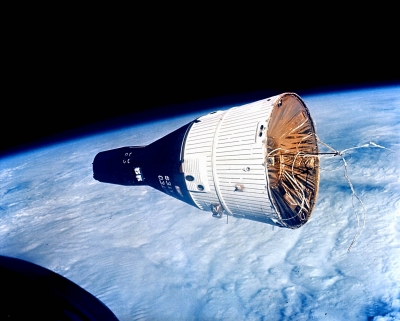
A rendezvous in space
Imagine being out in space in a spacecraft. You are likely to have a few others for company, but for your spacecraft as such, it will mostly be lonely in the region of space it inhabits. How would you feel when another spacecraft with people on board come close by, almost within touching distance? The first such human rendezvous in space was conducted on December 15,1965, by those aboard the Gemini VI and Gemini VII spacecraft.
Gemini VI and VII, however, were never meant to fly together at the same time. What with the moon mission coming ever closer, Gemini VI was set to test rendezvous manoeuvres, while Gemini VII was to carry out extended space-flight experiments.
A target explodes
Even though Gemini VI was ready to fly on its intended launch date of October 25, 1965, it did not take off as the Gemini Agena Target vehicle it was supposed to rendezvous with exploded. It was then that a “rapid-fire” launch proposal was considered again.
According to this proposal, a Gemini spacecraft would target another Gemini spacecraft in space. Even though such an idea was explored previously, it was considered to be extremely unsafe to fly two manned spacecraft at the same time. But it was approved in the end, and it was decided that Gemini VI would rendezvous with Gemini VII, while experiments.
Seven before six
Gemini VII was to be launched first and it took off on December 4, 1965. The crew members- commander Frank Borman and pilot James Lovell – were scheduled to perform 20 experiments during their 14-day stay in space, apart from providing a target for Gemini VI.
For a second time, Walley Schirra and Thomas Stafford – crew members of Gemini VI – were suited up and ready for mission on December 12. Even though the engines ignited, the vehicle didn’t take off. Engineers worked on the failure and realized that a plastic cover left on the gas generator port of a check value had caused an electrical anomaly.
The NASA staff replaced the generator but were now racing against time to ensure that Gemini VI was launched before Gemini VII’s scheduled return. The third launch that took place on December 15, 1965 finally turned out to be successful.
Once Gemini VI was in Orbit, Schirra and Stafford were tasked with the role of catching up with Gemini VII. It took them a good six hours before they could get anywhere close to Borman and Lovell.
No relative motion
After a few careful manoeuvres Gemini VI and VII achieved their rendezvous, the first such manned activity performed in space. As they revolved around the Earth, there was no relative motion between the two spacecraft. Gemini VI and Gemini VII got as close as 0.30 matrefrom each other during their next three revolutions around the Earth.
Having achieved what it set out to – a successful rendezvous mission – it was Gemini VI that splashed down first – Schirra and Stafford getting out safely on December 16. Borman and Lovell continued their scientific, technological and medical experiments for a couple of days, before they also made a successful landing on December 18.
Human space-flight improved by leaps and bounds in a single year in 1965. Apart from this successful human rendezvous in space, the year also saw human being put in orbit and brought back, achieve long-duration stay and perform extravehicular activity in space, apart from controlling their re-entry. The mission to the moon was getting ever closer.
Picture Credit : Google

